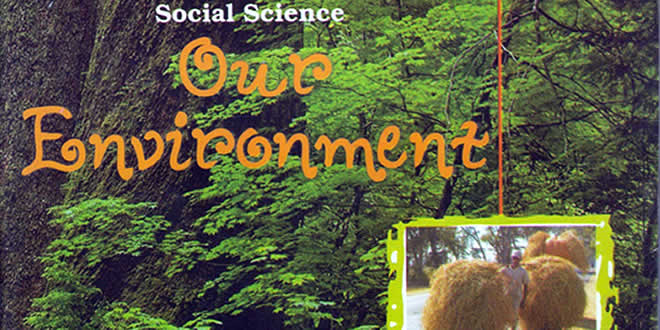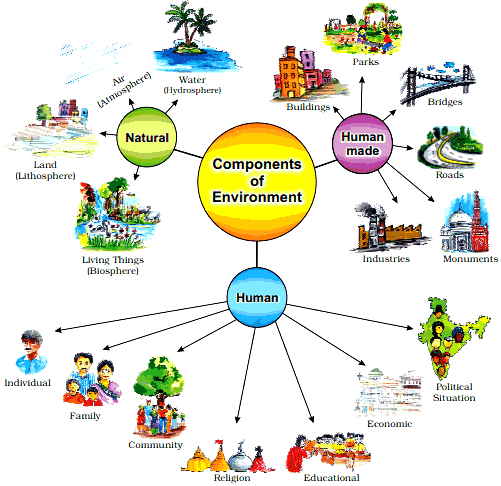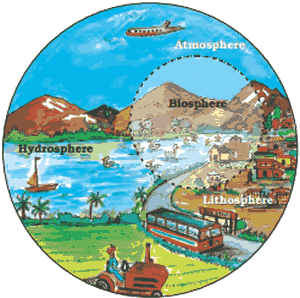Environment 7th Class NCERT CBSE Social Science Chapter 01
Question: What made Ravi sad while going to school after vacation?
Answer: After the long vacation while going to school Ravi noticed that the only play-ground next to the school is dug up. He was told that a multi-storey building would be constructed there.
This made him sad as the big playground with grass, marigolds and butterflies would be gone forever. He shared his feelings with his classmates.
Question: What all are the part of our environment?
Answer: Our Surroundings constitute environment. Buildings furniture like tables, chairs, open field, road, garbage etc. are all part of our environment. Some things like mountains, rivers, trees are created by nature. Others like chair, table, roads and clothes are made by man.
Question: Why is our environment changing?
Answer:
- It is all because of our needs
- They are increasing day by day
- We are therefore modifying and at times even destroying our natural surroundings
Question: How do human beings modify the environment?
Answer: Environment provides the basic life support system like air, water, food and land. The man made things like car pollute the air, factories build on land, containers for food and water are the examples of modification of environment.
Question: Distinguish between biotic and abiotic environments.
Answer:
Biotic Environment:
- The world of living organisms is called biotic environment
- Example: Plants and animals
Abiotic Environment:
- The world of non-living elements is called abiotic environment
- Example: Land
Question: Explain with examples the different components of environment.
Answer: Major Components of environment are: Man-made, natural and human beings
Major Components of the Environment:
Natural Components:
- Land (Lithosphere)
- Water (Hydrosphere)
- Air (Atmosphere)
- Living things (Organisms)
Human-made Components:
- Buildings
- Parks
- Bridges
- Roads
- Monuments
- Industries
Humans
- Individuals
- Family
- Community
- Religion
- Education
- Economic
- Political situation
Examples of Human-made Environment:
- Buildings
- Parks
- Bridges
- Roads
- Monuments
- Industries
Question: What is environment?
Answer: The surrounding in which we live forms environment. It is the basic life support system having natural and man-made components.
- The people, the place, the things, the nature and the living organisms that surround us are called environment
- It is a combination of natural and human made phenomena
- The natural environment refers to both biotic and abiotic conditions existing on the earth
- Human environment reveals the activities, creations and interactions among human beings
Natural Environment:
Question: What comprises natural environment?
Answer: Land, air, water, plants and animals are all the part of natural environment.
Question: Describe lithosphere and hydrosphere.
Answer:
Lithosphere
- It is the solid crust or the hard top layer of the earth
- It is made up of rocks and minerals
- It is covered by a thin layer of soil
- It is an irregular surface with various landforms like mountains, plateaus, plains, valleys etc
- Landforms spread over the continents and also on the ocean floors
Lithosphere provides us the following:
- Forests
- Grasslands for grazing
- Land for agriculture and
- Human settlements
- It is also a source of mineral wealth
Hydrosphere is the domain of water:
- It comprises various sources of water
- The different types of water bodies like rivers, lakes, seas, oceans, etc. are its major components
- It is essential for all living organisms
Question: Give an account of the atmosphere.
Answer:
- The atmosphere is the thin layer of air that surrounds the earth
- The gravitational force of the earth holds the atmosphere around it
- It protects us from the harmful rays and scorching heat of the sun
- It consists of numerous gases, dust and water vapour
- The changes in the atmosphere produce changes in the weather and climate
Question: Define the term ‘Biosphere’.
Answer: Biosphere: Plants and animals found in the narrow strip at the junction of lithosphere, atmosphere and hydrosphere together make biosphere.
Question: What do you understand by the term “Ecosystem”?
Answer: Ecosystem: An ecosystem is formed by the interaction of all living organisms with one another and with the physical and chemical factors of the environment in which they live. All are linked by transfer of energy and material. They are interdependent.
Question: Compare and contrast the climatic conditions of Kerala and Rajasthan.
Answer: Kerala, a southern state of India gets ample rainfall. It has lush green vegetation and coconut plantations.
Rajasthan, on the other hand, gets very less rainfall. It has thorny bushes, kikar and babul as vegetation.
Question: Name some animals found in deserts.
Answer: Camels, snakes, lizards, insects are found in deserts.
Question: Why do the animals and vegetation vary from place to place?
Answer: Animals and vegetation vary from place to place because
- They are dependent on their immediate surroundings.
- They depend on the environmental conditions like climate, soil, water etc.
- All of them sire interdependent on each other.
Question: What forms the ecosystem? Give some examples of ecosystems.
Answer: The relationship between the living organisms and their surroundings form the ecosystem. Rain forest, grassland, deserts, mountains, lake, river, ocean and pond are some of the examples of ecosystems.
Question: Define barter system.
Answer: Barter system is the exchange of goods without the use of money.
Question: What has brought a change in interaction between humans and their surroundings?
Answer: Human being modifies nature according to their need. Early humans adapted themselves to their natural surroundings. They led a simple life fulfilling their needs from nature.
With changes in needs new methods and technologies were invented. Settled life brought agriculture domestication of animals. Invention of wheel, surplus food led to development of trade and commerce. Barter system emerged.
Industrial revolution, changes in transportation increased production. Growth in communication system made life easier and speedy. Humans learned new ways to use and change the surroundings.
Question: What is important for a harmonious life?
Answer: Certain things are used in a certain way like watermelon in summer or roasted peanuts in winter. We need a balance between natural and human environment. Human beings must use their natural environment in a sustainable way to maintain the balance.
Question: Why did Nurie invited Ravi to her place?
Answer: Ravi was upset at losing his playground to building construction. Nurie invited him to her home in Mizoram in the lush green surroundings.
Question: Fill in the blanks with appropriate words:
- Hydrosphere is a part of ………………
- Two main constituents of environment are ……………… and ………………
- ……………… is the hard top layer of the earth.
- ……………… modify the natural environment.
Answer:
- biosphere
- natural, man-made
- Lithosphere
- Human beings
Question: Write whether the given statements are true or false:
- Landforms are found only over continents.
- Trade in which goods are exchanged without the use of money is called barter system.
- Gravitational force of the earth holds the atmosphere around it.
- No life can exist in biosphere.
- Abiotic environment consists of living organism.
Answer:
- False
- True
- True
- False
- False
Question: Answer the following questions briefly.
- What is an ecosystem?
- What do you mean by natural environment?
- Which are the major components of the environment?
- Give four examples of human-made environment.
- What is lithosphere?
- Which are the two major components of biotic environment?
- What is biosphere?
Answer:
- All plants, animals and human beings depend on their immediate surroundings. They are also interdependent on each other. This relation between the living organisms as well as the relation between the organism and their surroundings form an ecosystem.
- Natural environment consists of land, water, air, plants and animals. Thus, natural environment refers to both biotic (plants and animals) and abiotic (land) conditions that exist on the earth.
- The major components of the environment are—natural (land, air, water, living things), human made (buildings, parks, bridges, roads, industries, monuments etc.) and human (individual, family, community, religion, educational, economic etc).
- Four examples of human-made environment – buildings, parks, bridges and roads.
- Lithosphere is the solid crust or the hard top layer of the earth. It is made up of rocks and minerals and covered by a thin layer of soil. It is an irregular surface with various land forms such as mountains, plateaus, plains, valleys, etc.
- Plants and animals are the two major components of biotic environment.
- Biosphere is a narrow zone of the earth where land, water and air interact with each other to support life. Thus, plant and animal kingdom together make biosphere i.e. the living world.
Question: Tick the correct answer.
- Which is not a natural ecosystem?
(a) Desert
(b) Aquarium
(c) Forest - Which is not a component of human environment?
(a) Land
(b) Religion
(c) Community - Which is a human made environment?
(a) Mountain
(b) Sea
(c) Road - Which is a threat to environment?
(a) Growing plant
(b) Growing population
(c) Growing crops
Answer:
- (b)
- (a)
- (c)
- (b)
Question: Match the following:
- Biosphere
- Atmosphere
- Hydrosphere
- Environment
- a) blanket of air which surrounds the earth
- b) domain of water
- c) gravitational force of the earth
- d) our surroundings
- e) narrow zone where land, water and air interact
Answer:
- —(e)
- —(a)
- —(b)
- —(d)
Question: Give reasons:
- Man modifies his environment
- Plants and animals depend on each other.
Answer:
- Man modifies his environment to fulfill his needs and make his life comfortable. He also modified his environment to adopt himself to the natural surroundings.
- Plants and animals depend on each other for their own sake. Plants release oxygen that animals breathe and absorb carbon dioxide that animals release.
Question: What is environment?
Answer: Everything that we see in our surroundings forms environment. It is our basic life support system. It provides us air, water, food and land – the basic needs of our life.
Question: Why is our environment changing?
Answer: Our environment is changing because our needs are increasing day by day. To fulfill these needs we often don’t think about the environment and start modifying it.
Question: What are the basic components of natural environment?
Answer: The basic components of natural environment are – land, water, air, plants and animals.
Question: What does lithosphere provide us?
Answer: Lithosphere provide us forests, grasslands for grazing land for agriculture and human settlements. It is a rich source of minerals.
Question: Name different types of water bodies.
Answer: Rivers, lakes, seas, oceans etc.
Question: How is atmosphere important for us?
Answer: Atmosphere protects us from the harmful rays and scorching heat of the sun.
Question: What do you see in the deserts? Name some animals.
Answer: We see camels, snakes, lizards and insects.
Question: What is barter system?
Answer: Barter system is a method of trade in which goods are exchanged without the use of money.
Question: Distinguish between biotic and abiotic environment with examples.
Answer:
- The world of living organisms is known as biotic environment. Example: plants and animals.
- The world of non-living element is known as abiotic environment. Example: land.
Question: How is environment important for us?
Answer: It is important for us because it is the provider of air, water, food and land— the basic necessities of life.
Question: Write a note on lithosphere.
Answer: Lithosphere is the solid crust or the hard top layer of the earth. It is made up of rocks and minerals. It is covered by a thin layer of soil. It is an irregular surface with various landforms such as mountains, plateaus, desert, plains, valleys etc. Lithosphere plays an important role in our life. It provides us forests, grassland for grazing , land for agriculture and human settlements. It is also a treasure of various minerals.
Question: Give an account of atmosphere.
Answer: Atmosphere is the thin layer of air that surrounds the earth. It is made up of various gases such as oxygen, nitrogen, carbon dioxide, dust particles and water vapour. The gravitational force of the earth holds the atmosphere around it. It protects us from harmful rays and scorching heat of the sun. The changes in atmosphere produce changes in the weather and climate.
Question: How do human beings modify natural environment?
Answer: The needs of human beings are increasing day and day. Hence, they modify natural environment to fulfill these needs. Sometimes they even destroy their environment.
Human beings have made cars for their convenience. These cars release fumes which pollute the air. They have established factories on land. These factories manufacture various items such as containers. This is how they modify natural environment.
Question: Give an account of various domains of the environment.
Answer: Various domains of the environment are:
- Lithosphere
- Atmosphere
- Hydrosphere
- Biosphere
- It is the solid crust or the hard top layer of the earth. It is made up of rocks and minerals and covered by a thin layer of soil. It provides us forests, grasslands and land. It is a source of mineral wealth.
- It is the thin layer of air that surrounds the earth. The gravitational force of the earth holds the atmosphere around it. It protects us from harmful rays and scorching heat of the sun. It consists of various gases, dust and water vapour.
- It refers to various water bodies such as rivers, lakes, seas, oceans, etc. that exist on the earth.
- Biosphere or the living world is comprised of plant and animal kingdom. It is a narrow zone of the earth where land, water and air interact with each other to support life.
Question: How have human beings adapted to the environment to fulfill their needs?
Answer: Human beings from the early times have been interacting with the environment and modifying it according to their needs. Early humans adapted themselves to the natural surroundings. They led a simple life and fulfilled their requirements from the nature around them. But their needs kept on increasing. They became varied also. To fulfill these varied needs, humans learnt to grow crops, tamed animals and began a settled life. The wheel was invented, surplus food was produced, barter system emerged, trade started and commerce developed. Industrial revolution made possible large scale production. By and by transportation became faster. Information revolution made communication easier and speedy across the world. In this way human beings adapted to the environment in order to fulfill their needs.
 Class Notes NCERT Solutions for CBSE Students
Class Notes NCERT Solutions for CBSE Students




